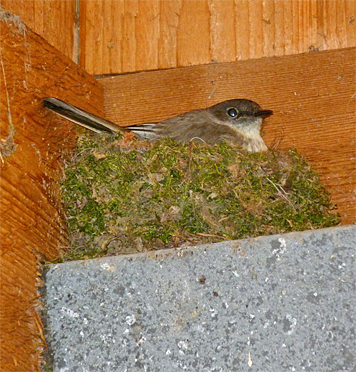
Sometime in March I noticed an Eastern Phoebe frequenting the vending area in Explore the Wild. Knowing that phoebes readily nest on ledges (rock ledges, wood ledges, block ledges, any kind of ledges) I hoped for a nest within easy viewing distance. There are plenty of ledges on the building that houses the restrooms and vending area. A nest there would be very convenient for anyone wanting to spy on a bird’s nest. Phoebes have nested below the boardwalk each year since I’ve been here at the Museum, but it’s difficult for a naturalist to see what’s going on down there.
The birds cooperated and built their nest on top of a block wall at the entrance to the vending area. Not long after, eggs were laid and incubation had begun.
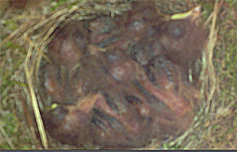
Somewhere around the second week of May I noticed that the bird was not sitting on the nest as much as it had been. I wanted to take a look at what was in the nest and this provided a good excuse to do so.
Out came the iPhone, some tape, and a long pole. I taped the iPhone to the pole, turned on the video and crept up on the nest. The image at right was taken from the video, not great quality (terrible quality) but you can see the reason for the adult’s absence, the eggs had hatched.
Things move quickly from here on, the birds grow rapidly, in two weeks they’d be off the nest. I was a bit concerned, and had been since this bird decided to nest here. This area is crowded with school kids during weekday mornings. Many fields trips come through the Museum in the spring. Everything from kindergarten, middle school, high school, and home school visit the Museum, and most of the kids pass through this vending area.
Our female did well, sitting on her eggs throughout the day while hundreds of kids passed by below. Once the eggs are in the nest the likelihood of the birds abandoning the nest decreases dramatically, even more so when the eggs hatch. There’s no way the birds will quite the nest with hatchlings in attendance. Our parent phoebes lived up to their duties, tirelessly bringing morsels of food throughout the long days.
The photo above of the hatchlings was taken on 10 May. Six days later, I took the photo below.
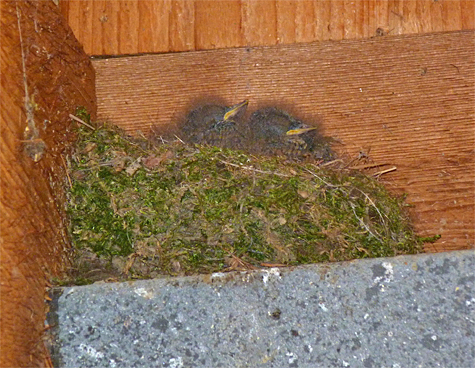
The next day…
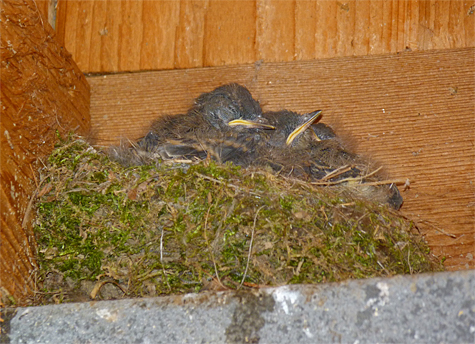
Four days after that…
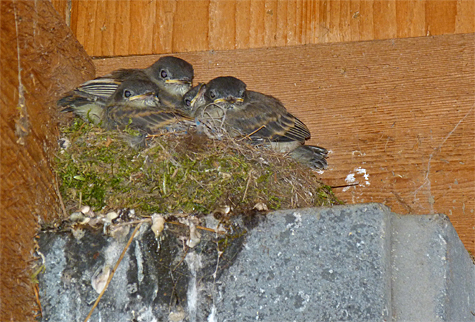
It’s here that I knew the time was near for these birds to leave the nest. If not that very day, it certainly would be the next. These things usually start in the morning, I was a bit worried about too many people being in the area, the birds may be trampled.
The following morning at around 9:45 I saw the quartet still at the nest. They had spilled over the nest and onto the ledge. It was going to happen soon, very soon.

Then I saw it, there on the ground, about ten feet from the nest, was another little phoebe, a fifth phoebe that I hadn’t seen before. It was the first one to leave the nest.
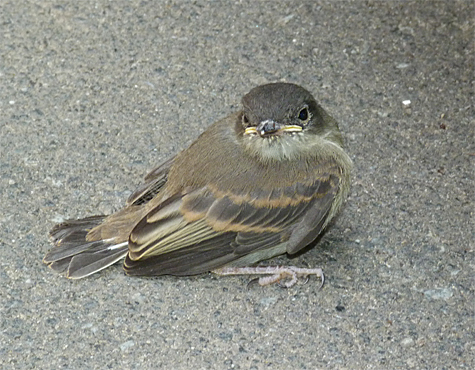
By 11:20 AM there were three birds left in the nest.
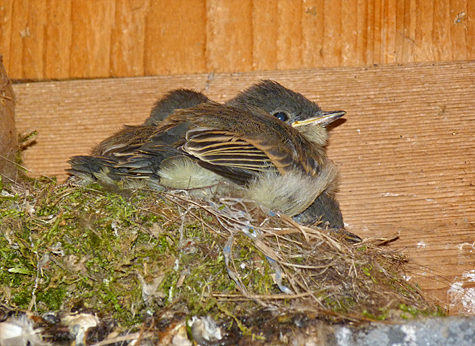
Luckily, it was not one of our busiest days. And, the birds did their part by timing their departures from the nest at times of low traffic. I was able to account for each bird throughout the day. It wasn’t until around 4 PM when the last bird left the nest. All birds had successfully made the transition from nestling to fledgling.
It would be their first night out in the open. No more being fed by their parents. Well, maybe a few more insects passed off to them by their parents, but the time has come to learn the ways of the world for these little birds. Being flycatchers, the young phoebes would now have to learn the art of capturing insects on the wing, how to snatch up a winged aphid, a hoverfly, even a dragonfly while in flight. They would also have to learn how to avoid being eaten themselves.
Many kids, teachers, and parents had a chance to see the phoebes in various stages of their lives from nest building to fledging. It was a great opportunity to point out to visitors what these birds were and to give impromptu lessons on their life histories.
I can’t wait to see what happens next out in the Wild!
————————————-
Read more about our phoebes here.
Those birdies are almost as cute as my new kitten!